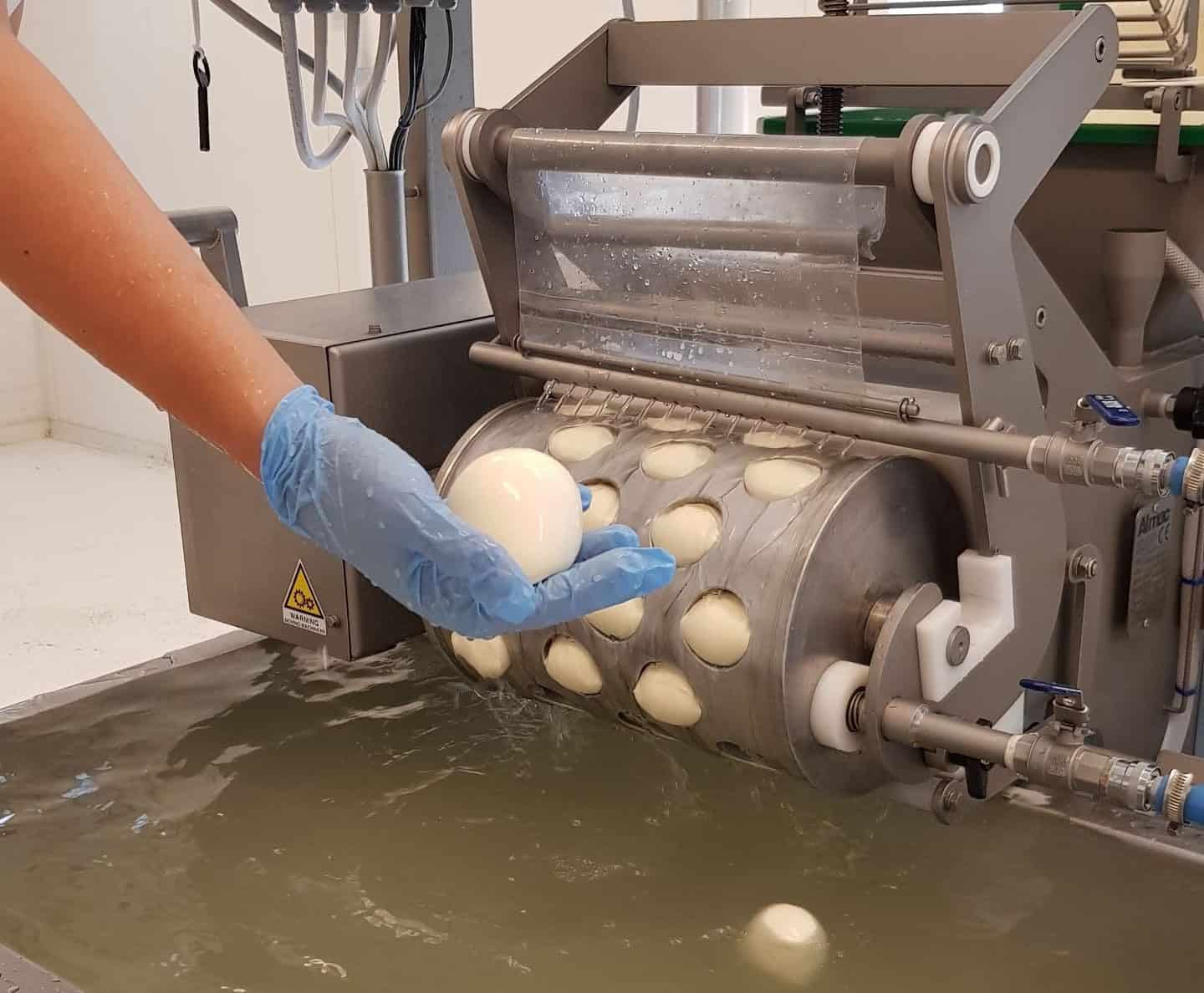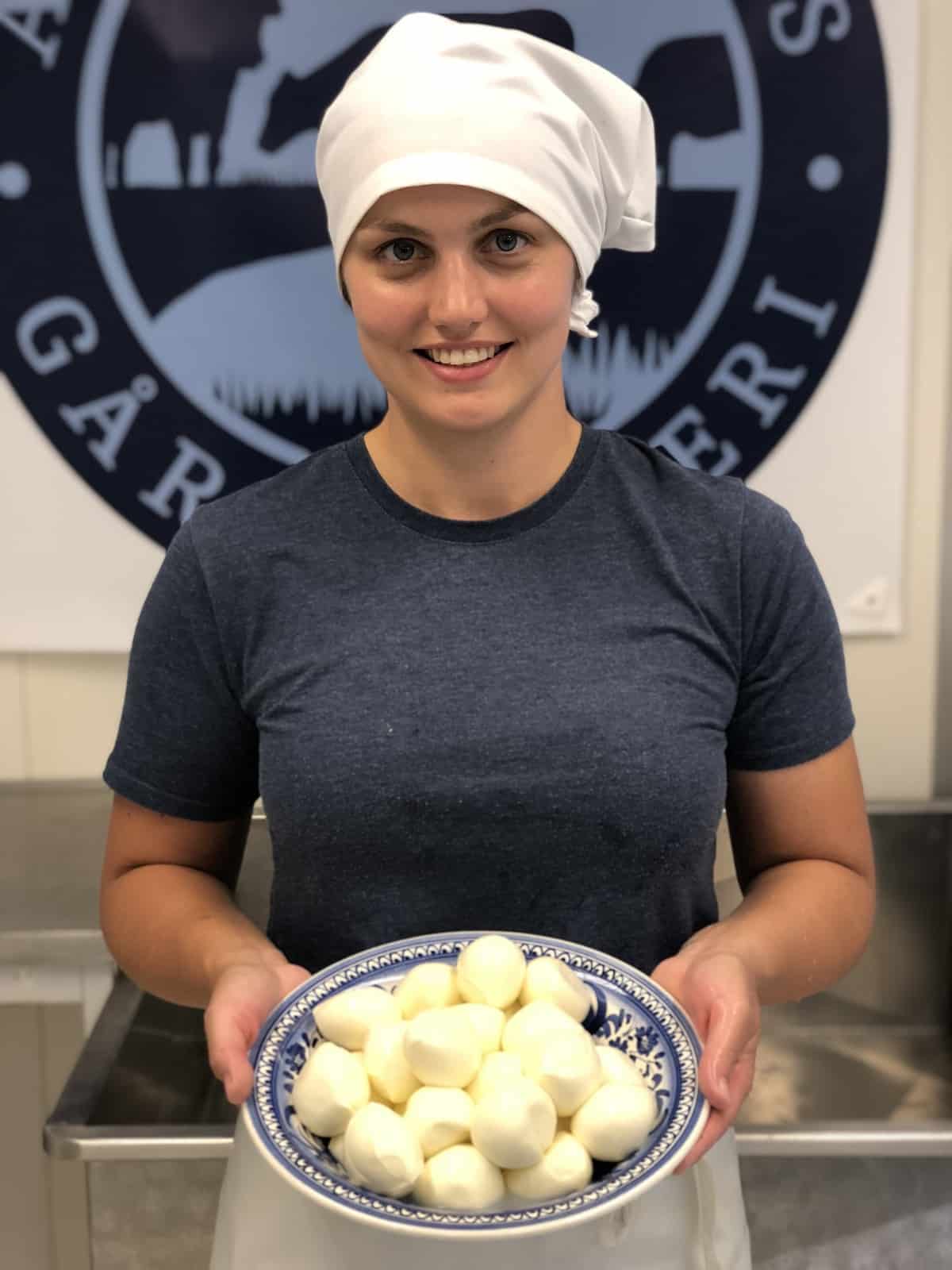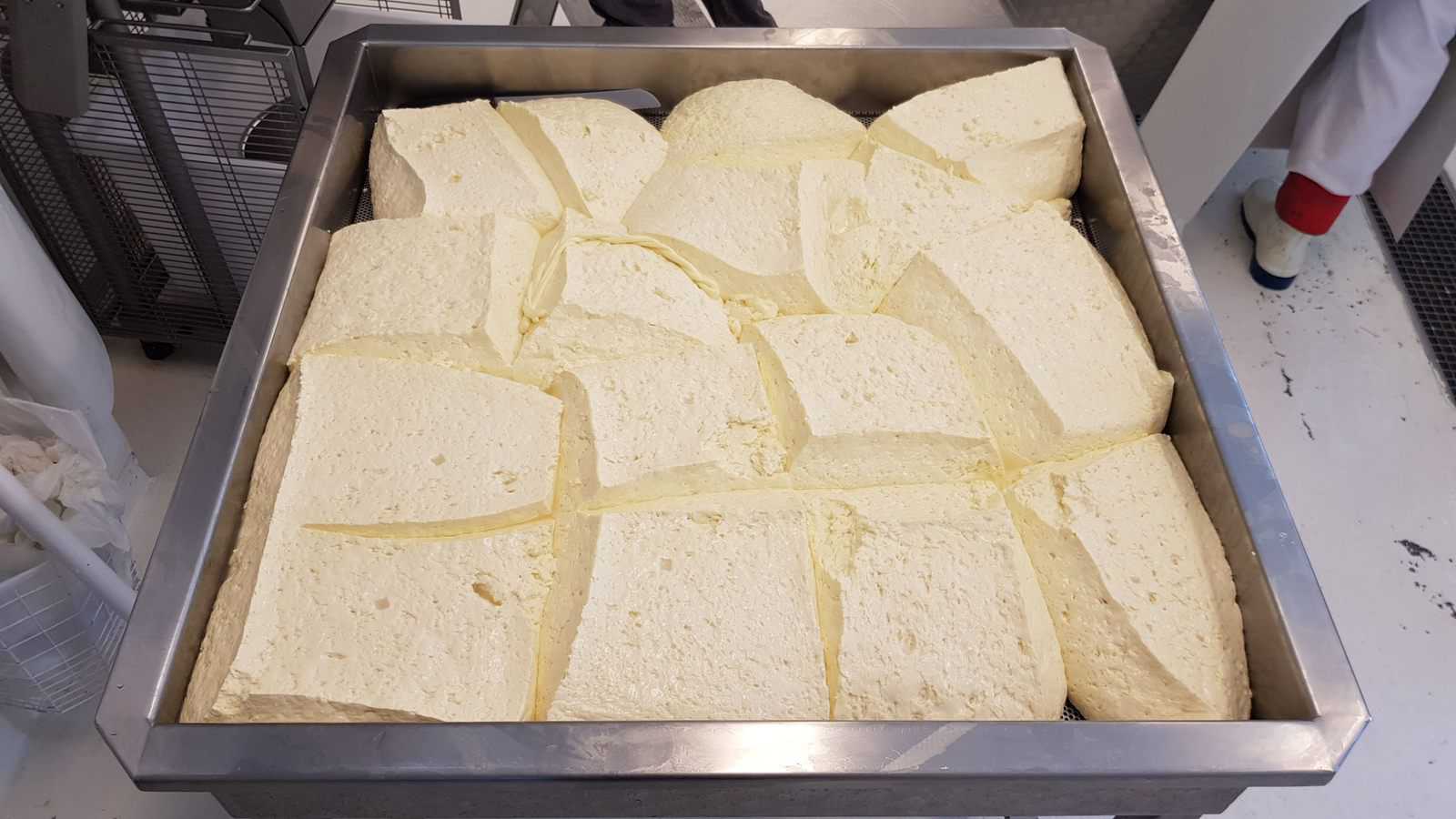
Stepping out of the car on a late Sunday morning, I’m greeted by a friendly Border Collie and warm sunshine. The buildings are quintessentially Swedish, painted a rich shade of red with white trim, surrounded by birch trees. I’m at Ängsholmens Gårdsmejeri, a small farm just north of Uppsala, Sweden, in a locality called Harbo, to chat with Linda Elvingson about her life as a mozzarella producer in a country that is definitely not Italy.
Her husband, Jonas, greets me and my own Swede, Johan, as we poke our heads into the dairy shop in search of Linda. “She needs a little more time,” Jonas says, as a visibly busy Linda darts between a milk vat and a curd-laden trolley, “but you can go visit the buffalo while you wait.”

As if making mozzarella in Sweden—where aged cheeses and earthy blues abound but soft, fresh varieties aren’t as prevalent—wasn’t unique enough, Linda and Jonas primarily produce cheese from the milk of their own water buffaloes. Though they are currently producing with the milk of neighboring cows due to a not-so-fruitful calving season, the Elvingsons have approximately 30 buffalo; many of whom Johan and I found grazing in a field as we strolled down a forest-lined dirt road. Despite swarming flies and the sun in my eyes, I was delighted to spend a few minutes with these inquisitive, sweet-natured creatures and thank them for their delicious contributions to the cheese world.
So, which came first: the buffaloes or the mozzarella? Curious to learn more about how the Ängsholmens Gårdsmejeri buffalo herd ended up in Sweden, I patted one last moist, sticky nose and headed back to the dairy to catch up with Linda and Jonas. Our timing was excellent, as a new batch of curds was just about ready to be turned into soft, stretchy, creamy balls of fresh cheese.

Linda Elvingson
As I helped with packing the morning’s first batch of mozzarella, I talked to Linda about her online presence. She’s active on Instagram, where she’s often vocal about sustainability.
“Why import mozzarella consisting of mostly water, when we can import the animal which will also do other good things to improve our environment?” With two master’s degrees in food and agriculture, Linda believes not only in the importance of being aware of where our food comes from, but also in the environmental impact of acquiring that food.
“I follow some cheese shops on Instagram and I’ll see them post things like, ‘Just picked up this mozzarella straight off the plane from Italy!’ and I think, that’s not sexy. Getting mozzarella off an airplane is not sexy.”
No airplanes were required for the piece of fresh mozz I popped into my mouth after finishing my packaging duties, and as far as I’m concerned, its salty, milky sexiness confirms Linda’s theory.
I liberated myself from apron and hairnet while Linda tended to visitors perusing the shop. In addition to mozzarella, the Elvingson duo makes scamorza, provola, a halloumi-style cheese they charmingly call Eldost (“fire cheese”), and the occasional burrata. Cheese-buying customers satisfied, Linda and I sat down for a chat before Johan and I made our own purchases and said hej då.

The curds are drained for the Swedish Mozzarella.
culture: Why did you decide to get into cheesemaking?
Linda Elvingson: I didn’t! I was studying medicine, but my parents had a dream to have a small dairy. They saw things changing here in Sweden some years ago, with farms shutting down and fields overgrowing. They found it very strange to see that part of our environment disappearing.
My parents decided to start a dairy and in 2012, they imported buffaloes from Germany, the first in Scandinavia. Around that time my dad said to me, “study food and agriculture instead,” and I realized I was more interested in that than in medicine after all. In medicine you don’t always see the best parts of people [laughs].
c: And why mozzarella instead of a more traditional Swedish cheese?
LE: Because fresh cheese is the only cheese you can make from buffalo milk. This whole thing was a project we started without knowing where it was going. We had no idea how to make the cheese, how to sell it, how much work it is.
c: So, the buffaloes came first, rather than the choice of cheese.
LE: We had cows too, but my father really wanted the buffaloes. Last year we decided to make cow’s mozzarella as well because there’s no one here doing it. We are in a market where everybody knows what mozzarella is, everybody has tasted it, but we have no competitors. It’s a unique thing in business when that happens, so I wanted to see how far we can get. Now we are here and we’re doing well! We deal with restaurant customers, which is a good thing. We can sell bulk and that’s what keeps us going.
c: Versus just waiting on customers.
LE: Individual customers are great, but they are time-consuming. They come here, they want to chat, they want to watch. It’s very seasonal, but every month this summer Jonas and I have sold enough to have a full-time salary for both of us. During the times we don’t have as many customers, the bulk sale really helps.
c: You’re sending your cheese to a wholesaler, does all that product stay in Sweden?
LE: Yes, though we have had our buffalo mozzarella go to Finland as well.
c: Do you hope to export more in the future, or do you prefer to stay within this region?
LE: There’s also a demand in Norway, but they have strict customs requirements since they’re not in the European Union, whereas we can just ship to Finland and Denmark, which isn’t really an “export.”
c: But nothing goes to the US or Canada?
LE: No. I always complain on my Instagram, “let’s not ship, let’s not fly in cheese,” so maybe I shouldn’t do that myself [laughs]. But I wouldn’t mind sending to the Middle East, maybe.
c: Have you had feedback on your cheese from anyone in Italy?
LE: Of course. I studied mozzarella in Italy and we had Italian technicians here when we bought the machines. It’s all authentic. We’ve also brought mozzarella to Italy and they thought it was very similar. We had theirs and mine together, side-by-side. The main difference was in color; mine was more yellow because the cows here are eating outside and these cows in Italy were only inside.
c: Do you have any “haters” because of your work?
LE: [laughs] Mansplaining happens sometimes on Instagram. A man will be like, “no, you can’t make burrata like this” or “this is wrong.” Sometimes they just feel the need to explain things to me, and I’m just like, “thanks for sharing.” People do talk a lot, but I don’t care.
c: Describe a day in the life of a Swedish mozzarella maker.
LE: Okay…we wake up at a quarter to 5 am, make coffee, get in the car—we live in Uppsala, we don’t live here—drive to the farm where we get the cow’s milk, pick up the tank and load the milk, come here to the dairy, and we do everything that we do for cheese production all day. We almost never have lunch. We’ll have some coffee, sometimes we’ll sit in the sun for a few minutes, sometimes we’ll have some customers. We leave at 7 or 8 pm. We go back to the farm to leave off the whey which will be used on the fields, we go back to Uppsala, and sometimes from there, Jonas will drive to Stockholm to deliver mozzarella. When he does this he usually gets home at 2 am. Every second day is like this, on our production days.
c: That’s a lot of work.
LE: It’s not really so much work. Sitting in an office all day with a boss is more exhausting than the work I’m doing now, I think. Jonas and I get to talk as we pack cheese, we listen to classical music as we clean, we enjoy that time together. It’s a way of life. I’ve never felt like this is too much, or that I don’t want to do it. Sometimes I’ll feel like “ugh,” as with anything else, but then I move on.
c: You and Jonas just got married—congratulations! And, according to Instagram, you’re into powerlifting?
LE: Thank you! We did just get married and we took two days off for that. I’ve been doing powerlifting for a couple of years, yes. I would like to train five days a week, but I don’t have time right now so I’m resting for a couple of months. I did manage to train three times per week until June; it’s important to have interests in your life beyond work.
This interview has been edited and condensed for clarity.



